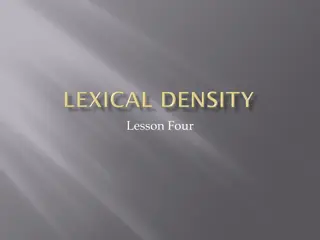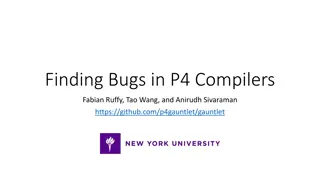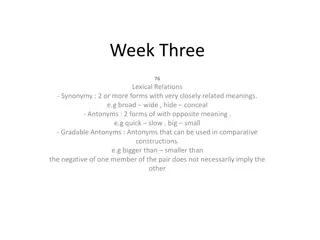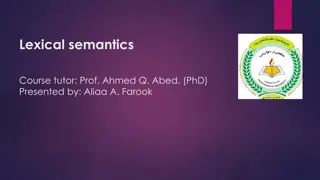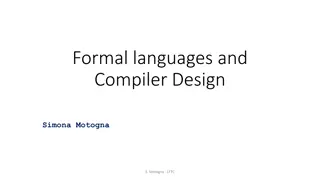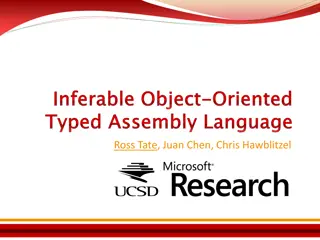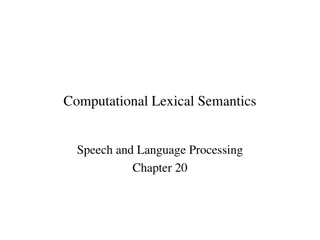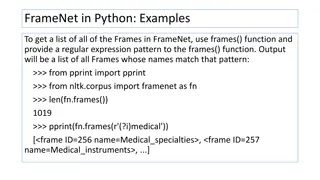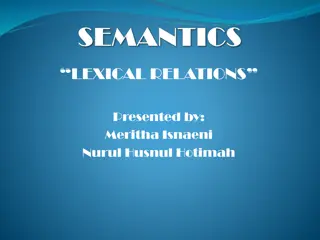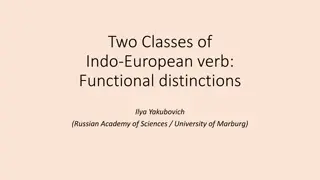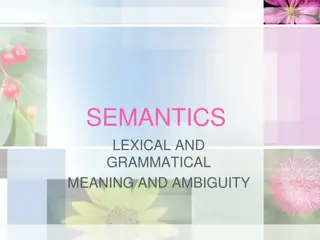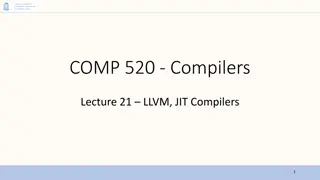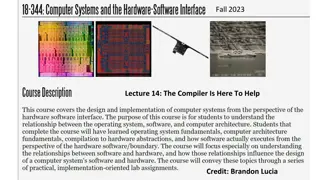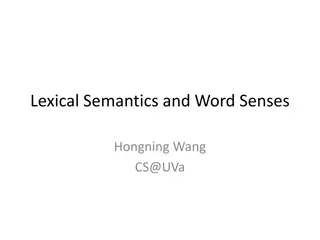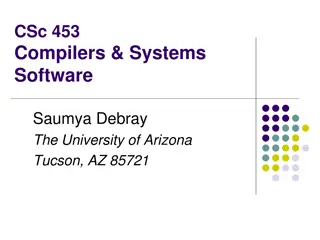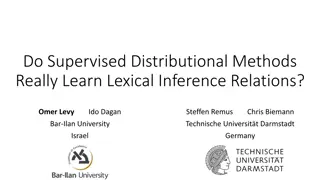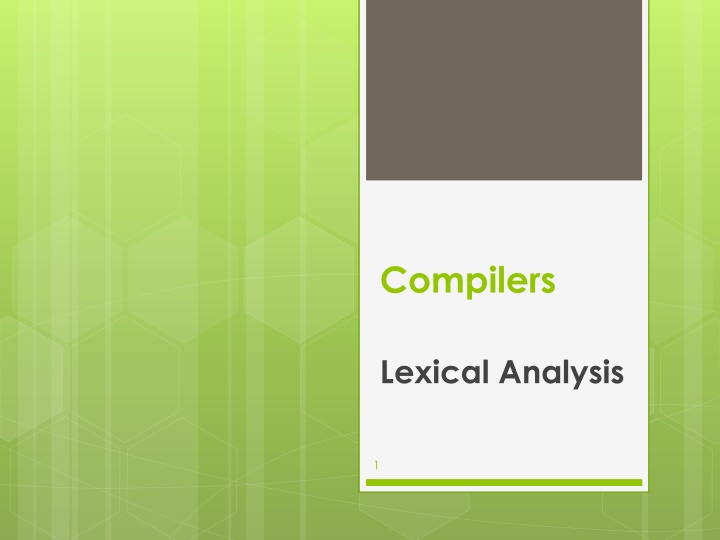
Lexical Analysis in Compilers: Understanding Tokens and Lexemes
Dive into the world of lexical analysis in compilers, where programs are transformed into sequences of tokens and associated lexemes. Explore the challenges, goals, and strategies involved in defining and choosing tokens for efficient program processing.
Download Presentation

Please find below an Image/Link to download the presentation.
The content on the website is provided AS IS for your information and personal use only. It may not be sold, licensed, or shared on other websites without obtaining consent from the author. If you encounter any issues during the download, it is possible that the publisher has removed the file from their server.
You are allowed to download the files provided on this website for personal or commercial use, subject to the condition that they are used lawfully. All files are the property of their respective owners.
The content on the website is provided AS IS for your information and personal use only. It may not be sold, licensed, or shared on other websites without obtaining consent from the author.
E N D
Presentation Transcript
Compilers Lexical Analysis 1
2 Lexical Analysis while (y < z) { int x = a + b; y += x; }
3 Lexemes vs Tokens Input Stream: while (y < z) { int x = a + b; y += x; } Token Stream: T_While T_LeftParen T_Identifier y T_Less T_Identifier z T_RightParen T_OpenBrace T_Int T_Identifier x T_Assign T_Identifier a T_Plus T_Identifier b T_Semicolon T_Identifier y T_PlusAssign T_Identifier x T_Semicolon T_CloseBrace
4 Goals of Lexical Analysis (Scanner) Convert from physical description of a program into sequence of tokens. Each token is associated with a lexeme. Each token may have optional attributes. The token stream will be used in the parser to recover the program structure. source tokens Scanner Parser
5 Challenges in Lexical Analysis How to partition the program into lexemes? How to label each lexeme correctly?
6 Defining a Lexical Analysis Define a set of tokens. Define the set of lexemes associated with each token. Define an algorithm for resolving conflicts that arise in the lexemes. It often consumes a surprising amount of the compiler s total execution time.
7 Choosing Tokens What Tokens are Useful Here? for (int k = 0; k < myArray[5]; ++k) { cout << k << endl; } For IntConstant Int Identifier = ( ) ++ { } << ; < [ ]
8 Choosing Good Tokens Give keywords their own tokens. Give different operators and punctuation symbols their own tokens. Discard irrelevant information (whitespace, comments)
9 Tokens in Programming Languages Operators & Punctuation + - * / ( ) { } [ ] ; : :: < <= == = != ! Each of these is a distinct lexical class Keywords if while for goto return switch void Each of these is also a distinct lexical class (not a string) Identifiers A signle ID lexical class, but parameterized by actual id Integer constants A single INT lexical class, but parameterized by int value Other constants, etc.
10 Defining Sets of Strings
11 String Terminology An alphabet is a set of characters. A string over is a finite sequence of elements from . Example: = { , } Valid strings include etc. The empty string of no characters is denoted . , , , ,
12 Languages A language is a set of strings. Example: Even numbers = {0, 1, 2, 3, 4, 5, 6, 7, 8, 9} L = {0, 2, 4, 6, 8, 10, 12, 14, } Example: C variable names = ASCII characters L = {a, b, c, , A, B, C, , _, aa, ab, }
13 Regular Languages A subset of all languages that can be defined by regular expressions. Any character is a regular expression matching itself. (a is a regular expression for character a) is a regular expression matching the empty string.
14 Operations on Regular Expressions If R1 and R2 are two regular expressions, then: R1R2: is a regular expression matching the concatenation of the languages. R1 | R2: is a regular expression matching the disjunction of the languages. R1*: is a regular expression matching the Kleene closure of the language (0 or more occurrences ). (R): is a regular expression matching R.
15 Example Example 3.4: Let = {a, b}. (page 122) 1. The regular expression a|b denotes the language {a, b}. 2.(a|b)(a|b) denotes {aa, ab, ba, bb}, the language of all strings of length two over the alphabet . Another regular expression for the same language is aa|ab|ba|b. 3. a* denotes the language consisting of all strings of zero or more a's, that is, { ,a,aa,aaa,...}
16 Example Example 3.4: Let = {a, b}. (page 122) 4. (a|b)* denotes the set of all strings consisting of zero or more instances of a or b, that is, all strings of a's and b's: {e,a, b,aa, ab, ba, bb,aaa,...}. Another regular expression for the same language is (a*b*)* 5. a|a*b denotes the language {a, b, ab, aab, aaab,...}, that is, the string a and all strings consisting of zero or more a's and ending in b.
17 Abbreviations The basic operations generate all possible regular expressions, but there are common abbreviations used for convenience. Typical examples: Abbr. Meaning Notes r+ (rr*) 1 or more occurrences r? (r | ) 0 or 1 occurrence [a-z] (a|b| |z) 1 character in given range [abxyz] (a|b|x|y|z) 1 of the given characters
18 More Examples re Meaning [abc]+ [abc]* [0-9]+ [1-9][0-9]* [a-zA-Z][a-zA-Z0-9_]*
19 Regular Definitions For notational convenience, we may give names to certain regular expressions and use those names in subsequent expressions, as if the names were themselves symbols.
20 Regular Definitions Example: Even Numbers (+|-| ) (0|1|2|3|4|5|6|7|8|9)*(0|2|4|6|8) Regular Definitions: Sign + | - OptSign Sign | (Sign ?) Digit [0 9] (0 | 1 | .. | 9) EvenDigit [02468] (0 | 2 | 4 | 6 | 8) EvenNumber OptSign Digit* EvenDigit
21 More Examples Example 3.5: (page 123) C identifiers are strings of letters, digits, and underscores. Here is a regular definition for the language of C identifiers. We shall conventionally use italics for the symbols defined in regular definitions. letter_ A|B| .|Z|a|b| .|z |_ digit 0 | 1 | | 9 id letter _( letter_| digit )*
22 More Examples Example 3.6: (page 123) Unsigned numbers (integer or floating point) are strings such as 5280, 0.01234, 6.336E4, or 1.89E-4. The regular definitions: digit 0 | 1 | ..... | 9 digits digit digit* optionalFraction .digits | optionalExponent ( E ( + | - | ) digits ) | number digits optionalFraction optionalExponent
23 More Examples Example 3.7: (page 124) we can rewrite the regular definition of Example 3.5 as: letter_ [A-Za-z_] digit [0-9] id letter_ ( letter_| digit )* The regular definition of Example 3.6 can also be simplified: digit [0-9] digits digit+ number digits (. digits)? ( E [+-]? digits )?
24 Implementing Regular Expressions Regular expressions can be implemented using finite automata. There are two kinds of finite automata: NFAs (nondeterministic finite automata) DFAs (deterministic finite automata) The step of implementing the lexical analyzer
25 Finite State Automaton A finite set of states One marked as initial state One or more marked as final states States sometimes labeled or numbered A set of transitions from state to state Each labeled with symbol from , or
26 Finite State Automaton Operate by reading input symbols (usually characters) Transition can be taken if labeled with current symbol -transition can be taken at any time Accept when final state reached & no more input Reject if no transition possible, or no more input and not in final state (DFA)
27 Example: FSA for cat Start Accept c a t
28 A Simple FSA
29 A Simple FSA
30 A Simple FSA
31 A Simple FSA
32 A Simple FSA
33 A Simple FSA
34 A Simple FSA
35 Example Example 3.14: (page 148) The transition graph for an FSA recognizing the language of regular expression (a|b)*abb is shown in Fig. 3.24.
36 Transition Tables We can also represent an FSA by a transition table, whose rows correspond to states, and whose columns correspond to the input symbols and The entry for a given state and input is the value of the transition function applied to those arguments. If the transition function has no information about that state-input pair, we put 0 in the table for the pair.
37 Transition Tables Example 3.15: (page 149) The transition table for the FSA of the example 3.14 is:
38 Acceptance of Input Strings by Automata Example 3.16: (page 149) The string aabb is accepted by the FSA of the example 3.14. The path labeled by aabb from state 0 to state 3 demonstrating this fact is: a a b b 0 0 1 2 3 Note that several paths labeled by the same string may lead to different states. For instance, path a a b b 0 0 0 0 0 This path leads to state 0, which is not accepting.
39 From Regular Expressions to NFAs Associate each regular expression with an NFA with the following properties: There is exactly one accepting state. There are no transitions out of the accepting state. There are no transitions into the starting state. Accept
40 Base Cases
41 Construction for st
42 Construction for s|t
43 Construction for s*
44 Example Construct the NFS for the regular expression (a l b)*abb NFA for a l b
45 Example NFA for (a l b)*
46 Example NFA for (alb)*abb
47 Speeding Up The Scanner A DFA is like an NFA, but with tighter restrictions Every state must have exactly one transition defined for every letter. -moves are not allowed.
48 From NFA to DFA constructs a transition table Dtran for DFA. Each state of DFA is a set of NFA states Note that s is a single state of NFA, while T is a set of states of NFA.
49 From NFA to DFA Example 3.21 : (page 154) for the NFA accepting (a1 b) *abb; -closure(0) = {0,1,2,4,7} = A since these are exactly the states reachable from state 0 via a path all of whose edges have label . Note that a path can have zero edges, so state 0 is reachable from itself by an -labeled path.
50 From NFA to DFA The input alphabet is {a, b). Thus, our first step is to mark A and compute Dtran[A, a] = -closure(move(A, a)) Dtran[A, b] = - closure(move(A, b)) Among the states 0, 1, 2, 4, and 7, only 2 and 7 have transitions on a, to 3 and 8, respectively. Thus, move(A, a) = {3,8). Also, -closure({3,8}) = {1,2,3,4,6,7,8} , so we conclude Dtran[A, a] = -closure(rnove(A, a)) = -closure({3, 8}) = B


